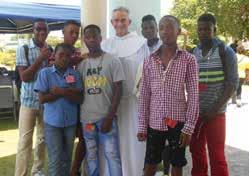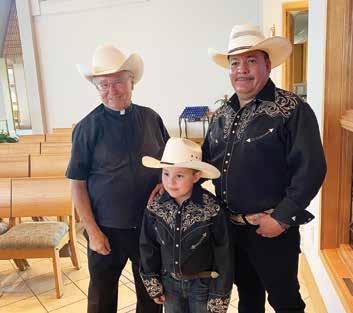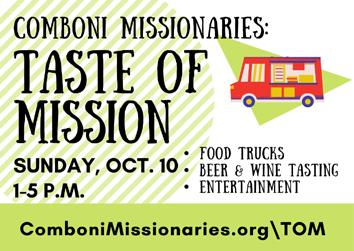
6 minute read
TO RUSSIA, WITH LOVE
BY MATT HESS
Bill Fuller, Missions Committee President at Holy Angels in Sidney, knows that while things have been less active the past year and half due to the pandemic, the committee who coordinates the parish’s mission twinning efforts is ready to get their parish excited again to help their brothers and sisters through Mary, Mother of God Mission Society in Vladivostok, Russia.
Advertisement
Holy Angels parishioners have a strong mission foundation, laid by past committee members, Sister Rita Maureen Schmidt, SC and Fran Holthaus, to build on in the coming year. Before the pandemic slowed their work, the parish held two fundraisers with proceeds going to Russia through the Mary, Mother of God Mission Society. This Californiabased non-profit works stateside for the mission, making sure all donations go to their designated destinations.
The first of these fundraisers was a sale of Russian icons, art and books at Holy Angels Church. After Mass, parishioners were able to purchase items that would not only grace their homes, but also assist the parish community that produced them. The second was a raffle, coordinated by Pam Leong. These efforts brought in more than $3,000 for the mission society.
Funds from Holy Angels are helping with many ministries sponsored by Mary, Mother of God Mission Society. “In particular, our efforts are inspired because there are many ministries to support: basic needs of food, clothing, medical treatment, women support centers (initially trained by Dayton volunteers), evangelization, elderly care, seminarians and capital and equipment projects, to name a few,” said Fuller.
However, the work that is most needed is that of Christ’s great commission: spreading the Good News. Throughout the decades of Communist rule, the faith of the Russian people was stamped out, with less than 1-percent of the population practicing any faith today. But, before the 1917 revolution, many ethnic groups settled in Vladivostok and brought the Catholic faith with them. Since 1992, Mary, Mary
Mother of God Mission Society and her 10 satellite parishes have worked to restore the Catholic faith in the area. They cover 500,000 square miles located near Russia’s border with China and North Korea on the Sea of Japan.
Father Myron Effing, CJD and Father David Maurer, CJD founded Mary, Mother of God Mission Society nearly 30 years ago. The reestablished parishes surrounding the Mission in Russia and their ministries show the growth and success of their missionary efforts. Their mission remains the same today: to bring material and spiritual support to the people of this area, while making their American benefactors aware of the many needs they encounter in Eastern Russia.
Holy Angels Church hosted Father Effing in the fall of 2019. He preached at Sunday Masses and challenged and inspired the faithful with the stories he shared. His visit was a way of thanking the community for their aid, as well as an invitation to continue their missionary work. Father Effing invited parishioners to Fuller hopes to organize a mission trip with other Holy Angel parishioners in the coming years when travel returns to normal.
“For me, this is a personal undertaking, having traveled and experienced Russia numerous times during the Soviet and then post-Communist era,” said Fuller. But a mission trip is not the only thing on the agenda in the coming years. Fuller hopes they can send children’s clothing made by parishioners, along with school supplies and devotional items. To build up the twinning parish program, the committee also plans to reach out to other American parishes who are also twinned with Russia to coordinate efforts and brainstorm how best to utilize their resources.
For Holy Angels Parish, the mission of Father Effing is theirs as well. The faithful seek to give those in Vladivostok more meaningful lives through Christ and His Church.
To view a list of all twinned parishes in the Archdiocese of Cincinnati, please visit: catholicaoc.org/offices/mission-and-pontificial-mission-societies
We have been called to heal wounds, to unite what has fallen apart, and to bring home those who have lost their way.
— St. Francis of Assisi
Following in the footsteps of St. Francis, we are serving the poor and underprivileged both at home and abroad in Cincinnati, New Orleans, Jamaica, and more. Covid-19 wreaked havoc on our missions, and your support during these challenging times is lifesaving. To help, visit Franciscan.org.
The Franciscan Friars, Province of St. John the Baptist • 1615 Vine St., Ste 1 • Cincinnati, OH 45202-6492 • Franciscan.org • 513-721-4700, ext. 3219
Mission
Yesterday and Today
BY LINDSAY BRAUD
The first Comboni novices to arrive in the U.S. in the 1940s.

What we know and experience as “mission” today is different from the mission of 500 years ago, or even 80 years ago. Under the auspices of Vatican II, the Church’s definition of mission changed, stripping away the colonial mindset and replacing it with the local Church.
When missionaries first arrived in the Americas and central Africa they not only converted others to the faith, they also imposed European social and cultural practices on the new Christians, in effect erasing their culture.
Today, “missionaries work in partnership with the people, enabling them to take charge of their own faith and community life,” wrote Comboni Missionary Father John Converset, MCCJ. “Most missionaries are now aware that every culture needs to be evangelized. In each culture, they value the positive elements which prepare it to receive the Good News.” Incorporating local traditions into the Catholic faith happens in many ways. For more than 150 years, the Comboni Missionaries have enculturated themselves into the communities they serve. It starts simply, by first learning the local language.
Father Joseph Bragotti, MCCJ will tell you that learning a new language is about more than just translating words. When you learn a new language, you learn a new way of thinking and of understanding the world around you. Once you understand a language, then you are ready to share the Gospel in a way people can appreciate.
Mission work today isn’t just about “winning souls” or “saving the lost.” Prior to Ad Gentes, the Second Vatican Council’s decree on missionary activity, most missionaries simply condemned other faiths as idolatrous and in error.
Fortunately, the Church’s attitude towards other faiths has evolved. “Today, missionaries are more willing to enter into dialogue with believers of other faiths. They recognize that the [Holy] Spirit has been at work among all peoples and there is much for Christians to learn from others,” wrote Father John Converset, MCCJ.
In Chad, where only 20-percent of the population is Catholic, disagreement between religious communities is common. That’s why, in 2006, Comboni Missionaries opened Abraham’s Tent, an interfaith center working to support Islamic-Christian dialogue. There, young people from diverse backgrounds can learn to overcome religious prejudice through lectures, debates and team-building exercises. This type of work would have seemed unfathomable prior to the 20th Century, and yet it is fundamental for healing broken communities.
A missionary must be flexible and willing to listen. This is especially true for Comboni Missionaries. When they first arrived in the U.S. in 1939, their mission was to support the African American Catholic communities in Cincinnati’s West End. Over the decades, their mission has changed.
With the construction of Interstate-75 and urban renewal plans from the city, came the destruction and displacement of the African American neighborhoods, including Holy Trinity parish. The Comboni Missionaries continued serving in parishes like St. Michael’s in Lower Price Hill, but in time, that parish also closed. It was time for a shift in ministry.
In 1998, the Comboni Missionaries accepted overseeing Hispanic Ministry for the Archdiocese of Cincinnati. This ministry is thriving, just as it is in the Comboni Missionaries’ other communities across North America. Today, Comboni Missionaries in the U.S. support largely Hispanic communities.
Who knows what the mission will look like in 20-years? Whatever changes arise, the Comboni Missionaries will be ready to serve.














